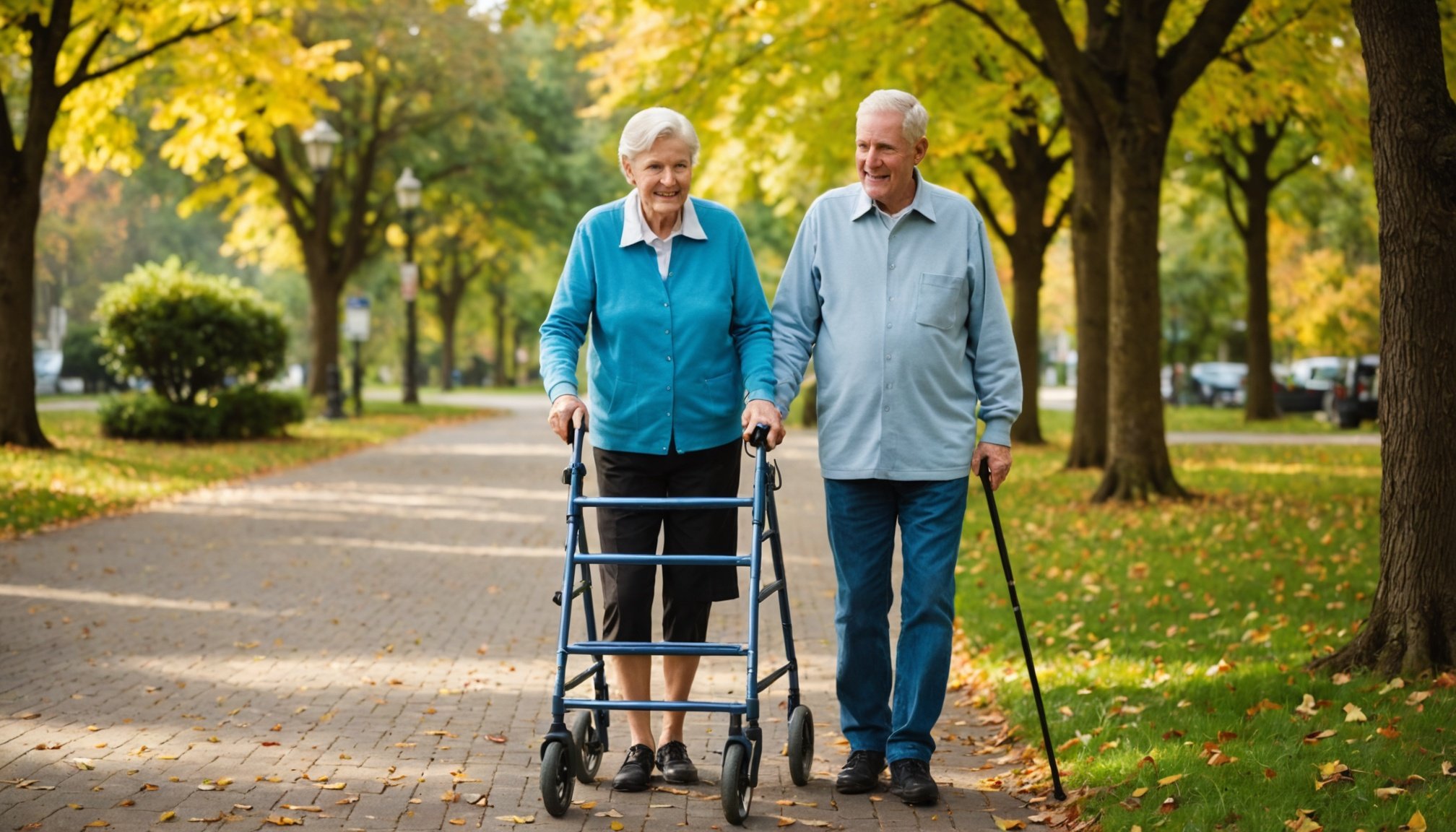Essential Factors for Seniors to Weigh When Deciding Between a Walker and a Cane
When it comes to maintaining mobility and independence, especially for older adults, the decision between using a walker or a cane can be crucial. Both walking aids serve the same primary purpose – to provide support and stability – but they have distinct differences that make one more suitable than the other depending on individual needs. Here’s a comprehensive guide to help you make an informed decision.
Understanding Your Mobility Needs
Before diving into the specifics of walkers and canes, it’s essential to understand your mobility needs. This involves assessing your balance, strength, and overall physical health.
Have you seen this : Essential Legal Strategies for UK Seniors to Effectively Manage Their Estates as They Age
Balance Issues
If you struggle with balance while walking, you may need an aid that provides more stability. According to the Centers for Disease Control and Prevention (CDC), falls are a significant risk for older adults, leading to approximately 3 million emergency department visits each year.
Physical Health
Your physical health, including any chronic conditions or recent injuries, plays a critical role in choosing the right walking aid. For instance, if you are recovering from a hip replacement surgery or managing arthritis, you may require different levels of support.
In parallel : Unlocking Recovery: The Impact of Speech Therapy on Stroke Rehabilitation for Seniors
Types of Walking Aids: Walkers vs. Canes
Walkers
Walkers are designed to provide maximum stability and support. Here are some key features and benefits:
- Stability and Support: Walkers offer four legs or wheels, providing a wider base of support, which is particularly useful for people with severe balance issues or those who need to bear less weight on their legs.
- Adjustable Height: Most walkers are adjustable, ensuring they fit comfortably and do not cause the user to lean forward or stretch.
- Additional Features: Some walkers come with seats, baskets, or other storage options, making them convenient for daily use.
| Feature | Walker | Cane |
|
|------------------------------------------------------------------------|
|
| Stability | Provides maximum stability with four legs or wheels | Offers single-point or quad-tip support |
| Adjustability | Generally adjustable to fit different heights | Often adjustable, but some models are fixed |
| Additional Features | May include seats, baskets, or storage options | Some models include seats or additional handles |
| Weight Capacity | Typically higher weight capacity | Varies, but generally supports up to 250 pounds |
| Portability | Can be bulky and less portable | Generally more portable and collapsible |
| Grip Strength | Requires less grip strength due to wider base of support | Requires more grip strength and hand stability |
Canes
Canes are more versatile and can be used in a variety of situations. Here are some key features and benefits:
- Portability: Canes are generally lighter and more portable, making them easier to carry around.
- Adjustability: Many canes are adjustable, ensuring the right fit for the user.
- Grip Options: Canes come with various grip styles, such as T-handle, ergonomic, or offset handles, catering to different hand preferences and needs.
Choosing the Right Walking Aid
Consult a Professional
When choosing between a walker and a cane, it is highly recommended to consult with a healthcare provider or a physical therapist. They can assess your specific needs and recommend the most appropriate walking aid.
### Steps to Choose the Right Walking Aid
- **Assess Your Needs**: Determine the level of support and stability you require.
- **Consult a Professional**: Talk to a healthcare provider or physical therapist for personalized advice.
- **Consider Your Environment**: Think about where you will be using the walking aid most often.
- **Check the Weight Capacity**: Ensure the walking aid can support your body weight.
- **Evaluate Grip Strength**: Choose a walking aid that accommodates your grip strength and comfort.
- **Look for Additional Features**: Consider any additional features that might be beneficial, such as seats or storage options.
Height and Weight Considerations
The height and weight capacity of the walking aid are crucial factors. For canes, the elbow should be bent at a comfortable 15-20 degree angle when holding the cane. For walkers, the handle height should allow you to stand up straight without leaning forward.
Using Your Walking Aid Correctly
Proper Walking Techniques
Using a walking aid correctly is essential to ensure safety and effectiveness.
-
With a Cane:
-
Hold the cane in the opposite hand to the affected or weakest leg.
-
Move the cane simultaneously as you step forward with your bad leg.
-
Keep your elbow slightly bent to absorb shock and maintain balance.
-
With a Walker:
-
Stand inside the walker with your feet shoulder-width apart.
-
Hold the handles firmly but not too tightly.
-
Move the walker forward a few inches and step into it with the weaker leg first.
Safety Tips and Maintenance
Safety at Home
To prevent falls, it’s important to ensure your home is safe and free from hazards.
### Home Safety Tips
- **Remove Trip Hazards**: Clear your home of throw rugs, cords, and clutter.
- **Improve Lighting**: Increase the amount of light in your home by using brighter bulbs.
- **Install Railings**: Consider having railings installed on stairs and bars next to the tub or shower.
- **Wear Safe Footwear**: Use non-skid, rubber-soled shoes that fully support your feet.
- **Limit Alcohol Consumption**: Avoid excessive alcohol intake, as it can affect balance and increase the risk of falls.
Maintenance of Your Walking Aid
Proper maintenance can extend the lifespan of your walking aid.
### Maintenance Tips
- **Clean Regularly**: Clean your walking aid regularly to prevent dirt and grime buildup.
- **Check for Damage**: Regularly inspect your walking aid for any signs of damage or wear.
- **Store Properly**: Store your walking aid in a dry, secure place when not in use.
- **Replace When Necessary**: Know when it’s time to replace your walking aid to ensure continued safety and support.
Real-Life Examples and Testimonials
Using a Cane for Balance
For individuals with balance issues, a cane can be a lifesaver. One Amazon reviewer shared, “My wife needed radiation treatment following chemotherapy, which left her weak and unsteady on her feet. I bought her the Honeybull Walking Cane, and it worked well for her. She used it to stand up from sitting and to walk without falling or stumbling, which had happened before she got this cane. It is light to use and provides excellent stability. I highly recommend it.”
Using a Walker for Stability
For those who need more stability, a walker can be the better choice. A user of the Drive Medical Walker with a built-in seat noted, “I needed something portable to take to the casino in Atlantic City when I take my wheelchair-bound mother-in-law to play the slots. She’s there for a few hours, and I can’t stand that long and can’t take up a slot seat. So with this walker, I can sit Mom at the end of a row and then sit next to her on this walker/chair and help her.”
Choosing between a walker and a cane is not a one-size-fits-all decision. It requires careful consideration of your mobility needs, physical health, and the specific features of each walking aid. By consulting with professionals, understanding the different types of walking aids, and using them correctly, you can maintain your independence and safety.
As Calum Fraser, CEO and owner of Advantage Physiotherapy, emphasizes, “Canes are particularly useful following leg injuries that impact movement patterns or gait or for people with chronic diseases affecting their lower limbs, like arthritis.” Whether you opt for a walker or a cane, the right choice can significantly enhance your mobility and quality of life.
In the end, it’s about finding the walking aid that best supports your unique needs and ensures you can walk confidently and safely. By doing so, you can continue to live an active and independent life, even as your mobility needs evolve.











